Biostar iDEQ 200T: Great Performance & Brilliant Design
by Wesley Fink on September 29, 2003 10:24 PM EST- Posted in
- Systems
Biostar iDEQ 200T: iDEQ Chassis
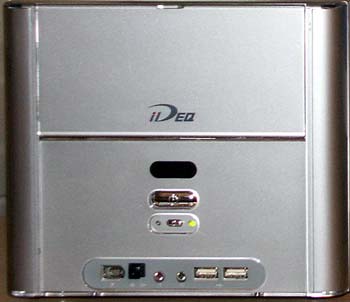
Biostar has taken the elegant cube idea to another level with the iDEQ chassis. The iDEQ chassis front appears to be brushed Aluminum and closed.
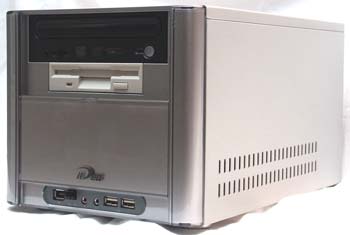
It is really a sliding plastic door designed to conceal the Optical and floppy drives until they are needed. Front ports are a very complete collection of Firewire, USB, SPDIF Optical IN, and Mic and Headphone mini jacks. Two front panel features show the attention to detail by Biostar: the front SPDIF IN port (and Rear OUT), and the slightly translucent sliding panel, which still allows operation LEDs to shine through even when covered.

The rear of the chassis is also thoughtfully designed. The iDEQ 200T includes 3 audio jacks easily configured for use with 6 speakers, SPDIF Optical OUT, PS2 mouse and keyboard ports, serial, VGA, firewire, 10/100 LAN, and 2 USB 2.0 ports. The 3 audio jacks can be easily configured to drive a 6-speaker audio system, while still retaining the front mic and headphone jacks. Also notice the punchouts for mounting a Parallel Port, Game Port, and additional Serial Port from internal headers. It has been very difficult to find even an optional Parallel Port on SFF machines, and the game port header is tuly unusual. Unlike some other SFF designs that seem to have “small” as their only design goal, the Biostar was clearly designed with a great deal of thought as to how a computer user really works and how they might use peripherals and ports.

The brushed aluminum shell includes air inlet grills low on both sides of the chassis, which assist airflow for cooling.

Instead of a bulky one-piece chassis cover, Biostar has used separate side and top panels for the iDEQ chassis. While this is a very good idea, be aware that the side panels should be removed before you attempt to remove the top panel.
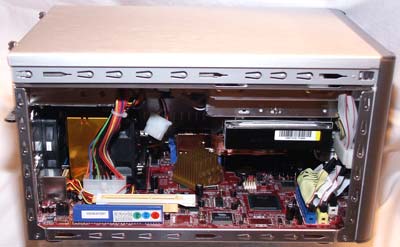
As you can see in our open view of the chassis, we have loaded the Biostar system with a CD Recorder/DVD combo, floppy, and a 120 Gb hard drive. Even with all of these peripherals installed, the interior is still well-organized and uncluttered, especially considering the small size of the system.
You can see that the AGP 8X and PCI slot, are accessible from the left side, but you may not notice that the AGP slot is on the inside instead of outside, as we see on other SFF designs. This means that the Biostar can actually mount the 2 slot AGP 8X cards from nVidia and other vendors, in addition to ATI Radeon and other one-slot cards.
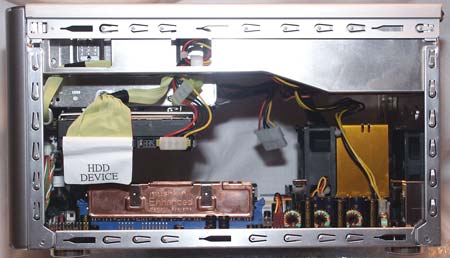
The 2 Dual-Channel DIMM sockets are also accessible from the right side, making it easy to swap memory in the iDEQ 200T without disassembling the SFF computer. This is a much better solution than other designs that place the memory slots parallel to the front. That arrangement, used by many competitors, often requires removing the drive cage just to change DIMMs. Most other designs come with prepared cables that you will need to route according to directions before installing drives. The Biostar came with all cable preinstalled, cleverly routed, and clearly labeled. In fact, the iDEQ 200 is the first SFF where we could actually install all the drives, memory, and CPU without having to remove the drive cage.
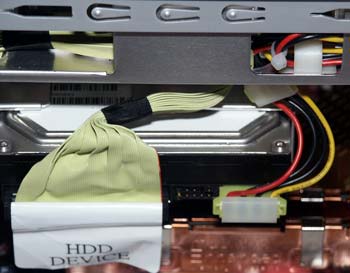
You will have to loosen a large screw and slide out the hard drive cage to mount the hard drive, but this is a simple release of the right catch on the sliding HD tray. Biostar also tells us that there is an optional dual hard drive cage for those who wish to use RAID with the Intel ICH5R Southbridge. Please contact Biostar for more information on the dual-drive cage.
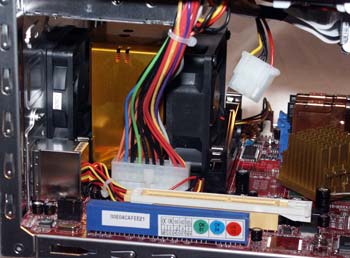
The cooling system for the Biostar consists of a variable speed large 80 cm rear-facing CPU fan blowing over copper fins covering heatpipes mounted on a copper plate, which cover the CPU. Hot air is then exhausted just behind the CPU cooling module with another rear mounted System fan. The iDEQ 200T cooling solution was very effective in our tests. We set fans on “Smart Fan” to vary speed as needed to keep the unit quiet. Not once during our testing did Smart Fan turn on the fan high setting in our air-conditioned lab.

The attention to a total cooling solution even extends to the aluminum bottom of the Biostar iDEQ 200T, where the depressions are designed to mate with the locations of the CPU, Northbridge and Southbridge. Effectively, this turns the bottom of the case into a giant heatsink.
If you would like to know more about how the Biostar cooling system works, check out the additional information at Biostar.
The AGP and PCI slot can be fully accessed even with a fully loaded system.

Installation of a Biostar is the easiest that we have ever seen on an SFF with all of the pre-installed and pre-routed cabling. However, if you haven’t mounted cards before in an SFF, the arrangements will not seem very intuitive. Biostar’s design is very similar to the very efficient one pioneered by Shuttle. As you can see in the above photo of the very similar Shuttle card cage, 2 screws secure the slots. You must remove both screws and flip up the hinged top cover by pushing out from the inside of the case just above the slots. You can then easily add or remove a PCI or AGP card.
The iDEQ 200T design is both flexible and easily adapted to your needs. The attention to detail is superb. We had the Biostar out of the box, assembled and running faster than any SFF that we have previously tested. The pre-installed cabling combined with the hard drive slide meant that we could assemble the Biostar without removing the cage or having to route any cables. Biostar deserves congratulations for delivering the easiest to set-up SFF on the market.










23 Comments
View All Comments
Anonymous User - Tuesday, September 30, 2003 - link
50-60dBA is conversation level volume. Of course, its white noise and relatively low frequency. I have serious doubts that your tower is 30dBA (except for the advertisement that says it is). about 35 dba is on the threshold of a whisper. Unless you live in a soundlab your ambient noise level should be around 30dba.Anonymous User - Tuesday, September 30, 2003 - link
Yeah, #1 (uh.. and #2, doublepostage?) is right. 60dB is fscking loud, as anyone who's owned a Black Label can attest. My tower used to put out ~40 decibels of noise, and it was a touch loud (didn't bother me much though). "So?" you say? 50 decibels is 10 times 40 decibels. The wonders of non-linear scales.Anonymous User - Tuesday, September 30, 2003 - link
Am I missing something here? How can 50-60 dBA be considered quiet? That's freight train level noise for a PC, especially with the quieter towers coming in at about 30 dBA.